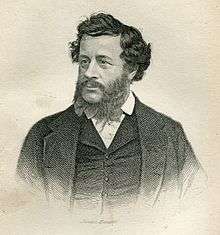Charles Elmé Francatelli



Charles Elmé Francatelli (1805–10 August 1876) was an Italian British cook,[1] known for his cookery books popular in the Victorian era, such as The Modern Cook.
Biography
Francatelli was born in London, of Italian extraction, in 1805, and was educated in France, where he studied the art of cookery. Coming to England, he was employed successively by various noblemen, subsequently becoming chief chef of the St James's Club, popularly known as Crockford's club. He left Crockford's to become chief cook to Queen Victoria from 9 March 1840 to 31 March 1842,[2] and then returned to Crockfords. He was managing steward of the Coventry House Club from the day it opened on 1 June 1846 until it closed on 25 March 1854, and at the Reform Club from 1854 to 1861. He was Manager of the St James's Hotel, at the corner of Berkeley Street and Piccadilly, from 1863 to 1870. He worked as chef de cuisine to the Prince and Princess of Wales at the nearby Marlborough House from 1863 to 1865. From 1870 to 76 he was manager of the Freemason's Tavern.[3][4]
One of his descendants was Laura Mabel Francatelli (1880–1967), who, from around 1909 to 1920, was a secretary to British fashion designer Lucy, Lady Duff-Gordon. Together with her employer and her employer's husband, Laura Francatelli was a survivor of the RMS Titanic disaster.
Works
Francatelli was the author of The Modern Cook (1845);[5] of A Plain Cookery Book for the Working Classes (1852), The Cook's Guide and Housekeeper's & Butler's Assistant (1861), and of The Royal English and Foreign Confectionery Book (1862). Francatelli died at Eastbourne.
A Plain Cookery Book for the Working Classes was reprinted in 1993, complete with the original advertisements and introduction.
Reception
Clarissa Dickson Wright, describing Francatelli as "the Italian confectioner", describes him as liking "his elaborate sugar decorations. He also talks about making pearls, birds and feathers out of sugar to decorate your dessert course." She compares it to a meal in Daisy Ashford's The Young Visiters, and comments that while such fiddly decoration may have looked good, she wasn't sure it did anything for the taste.[6]
See also
References
- ↑

- ↑ Account books of the Lord Steward of the Royal Household for 1840-42, National Archive, Kew, refs. LS 2/66, LS 2/67 and LS 2/68
- ↑ Colin Smythe, "Charles Elmé Francatelli, Crockford's and the Royal Connection" in Petits Propos Culinaires 101 (2014), pp. 42-67, and "Charles Elmé Francatelli, Additions & Supplementations" in Petits Propos Culinaires 102 (2015), pp. 100-118
- ↑

- ↑ The Modern Cook
- ↑ Wright, Clarissa Dickson (2011). A History of English Food. Random House. pp. 340–341. ISBN 978-1-905-21185-2.